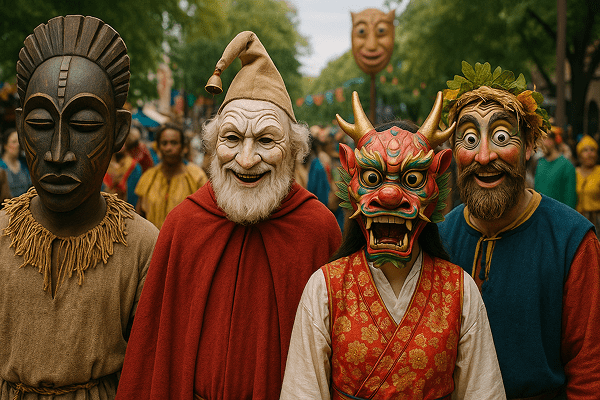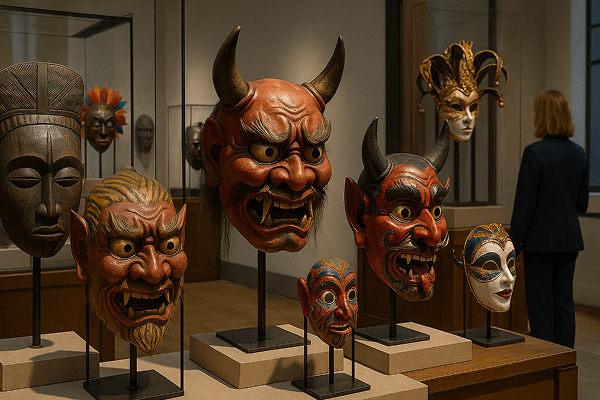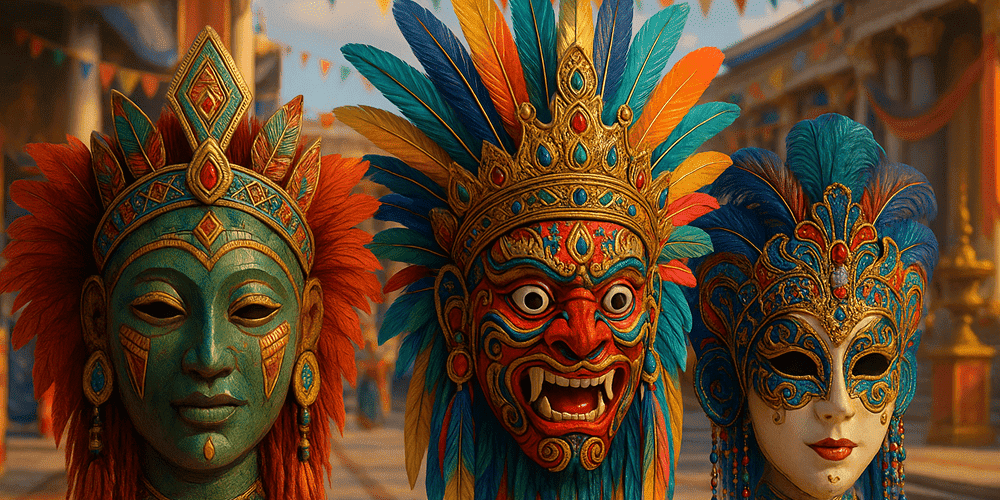Festival Ceremony Masks are among the most visually spectacular and culturally meaningful artifacts found in global celebrations. Marked by vivid colors, dramatic shapes, and symbolic motifs, these masks are designed for use in public festivities, sacred rites, and communal gatherings. Festival Ceremony Masks may feature animal faces, ancestral spirits, gods, or abstract forms adorned with feathers, beads, paint, and textiles. Their primary function is to transform, protect, and entertain, helping participants embody myth, tradition, and communal identity. Originating in diverse regions — from Africa and Latin America to Asia and Europe — Festival Ceremony Masks have become an enduring symbol of cultural heritage and artistic innovation, and continue to inspire mask-makers and collectors worldwide. For deep dives into masks used in rites of passage, see also Initiation Ceremony Masks on toddmasks.com.
Historical Origins of Festival Ceremony Masks
The tradition of using masks in festival ceremonies dates back thousands of years. The word “festival” comes from the Latin “festivus,” meaning joyful or celebratory, while “mask” originates from the Latin “masca,” meaning spirit or specter. In ancient Egypt, Greece, and Rome, masks were worn during festivals honoring gods, marking the cycles of nature, or commemorating the dead.
Throughout the Middle Ages and Renaissance, masks became central to European carnivals, mystery plays, and folk festivals. In Africa, Asia, and the Americas, masks were integral to harvest celebrations, New Year’s rites, and ancestor worship. Designs and functions evolved over time, influenced by trade, colonization, religious change, and artistic movements. Notable historical milestones include the emergence of the Venetian Carnival mask in Italy, Japanese festival masks (such as Tengu and Oni), and the spectacular animal masks of the Dogon people in Mali. Today, Festival Ceremony Masks are a living tradition, continually reinterpreted by artists, performers, and communities.
Cultural Significance and Symbolism of Festival Ceremony Masks
Festival Ceremony Masks are rich in symbolism, embodying the beliefs, myths, and values of their cultures. In many societies, masks represent gods, spirits, or ancestors who are invoked to ensure fertility, protect the community, or mark the changing of the seasons. In other contexts, masks are used to lampoon authority, satirize social norms, or enact mythological stories.
Spiritually, masks may be considered sacred objects, believed to channel supernatural power or facilitate communication with the divine. Myths and legends abound — from African trickster spirits to Asian dragon gods and European fools — with each mask type embedded in a unique narrative context. Socially, masks are a tool for community bonding, creative expression, and the temporary suspension of everyday roles. In festivals, masks often symbolize renewal, unity, and the cycle of life and death.

Materials and Crafting Techniques of Festival Ceremony Masks
The artistry of Festival Ceremony Masks is reflected in their materials and techniques:
- Traditional materials: Carved wood, papier-mâché, ceramics, leather, metals, plant fibers, animal hides, shells, feathers, and beads.
- Crafting process: Begins with designing or sketching, followed by carving, molding, or weaving the base, then painting or staining, and finally embellishing with decorative elements.
- Special techniques: Include wood-burning, gilding, mosaic, embroidery, and layered construction for three-dimensional effects.
- Regional differences: African masks are known for bold lines and earth tones; Latin American festival masks are brightly painted and often depict animals or devils; Asian masks may use lacquer, gold leaf, or silk; European masks often feature metallics, sequins, and glass.
Color symbolism is vital: red for vitality, black for mystery, gold for divinity, and blue or green for nature and renewal. Each festival has its own distinctive palette and motifs. For mask-making tutorials and artisan interviews, see toddmasks.com.
Functions and Uses of Festival Ceremony Masks
Festival Ceremony Masks serve a variety of functions:
- Ritual and ceremonial use: Central to processions, dances, and rites marking harvest, New Year, or religious holidays.
- Theatrical application: Featured in street theater, folk plays, and myth reenactments.
- Festival and holiday use: Worn during Carnival, Day of the Dead, Mardi Gras, Chinese New Year, and countless local festivals.
- Modern application: Used in art exhibitions, educational workshops, parades, and tourism.
The use of masks has shifted over time, adapting to new social, religious, and artistic contexts. While some traditions are preserved intact, others have been adapted or revived in contemporary forms.
Regional Variations of Festival Ceremony Masks
Festival masks reflect the diversity of world cultures:
- Africa: Dogon, Bwa, and Yoruba masks for agricultural and ancestor festivals.
- Asia: Japanese Noh and Kyogen masks, Balinese Barong, Indian Kathakali, and Chinese festival masks.
- Europe: Venetian Carnival masks, Basque festival masks, and Slavic folk festival masks.
- Americas: Mexican Day of the Dead skulls, Brazilian Carnival masks, Haitian Rara masks, and Native American dance masks.
Each region’s masks are distinguished by unique materials, styles, and functions. Local specialties may include transformation masks, talking masks, or masks designed for specific dances or characters. Comparing Festival Ceremony Masks to other ritual masks, such as Initiation Ceremony Masks, reveals both shared themes and unique artistic signatures.
Famous Examples and Notable Collections of Festival Ceremony Masks
World-class examples of Festival Ceremony Masks are found in:
- The Metropolitan Museum of Art (New York): African, Oceanic, Asian, and Native American festival masks
- Musée du quai Branly (Paris): Global ceremonial masks
- Victoria and Albert Museum (London): Carnival and theatrical masks
- Museo Nacional de Antropología (Mexico City): Mexican festival masks
Private collectors and regional museums also display rare or historic masks. Notable artifacts include Venetian Carnival masks, Japanese Oni and Tengu, and Mexican devil masks. For curated digital galleries and provenance research, visit toddmasks.com.

Influence of Festival Ceremony Masks on Art and Culture
Festival Ceremony Masks have profoundly shaped visual art, theater, dance, literature, film, and fashion. Their dramatic forms inspire painters, sculptors, choreographers, and costume designers. In literature and cinema, masks symbolize transformation, identity, and the liminal space between the everyday and the extraordinary.
Fashion designers reference festival masks in collections and runway shows, while musicians and performers use masks to craft stage personas. The preservation, study, and celebration of festival masks are vital for maintaining cultural heritage and sparking artistic innovation.
Contemporary Status and Preservation of the Festival Ceremony Mask Tradition
The tradition of Festival Ceremony Masks is alive and flourishing. Master artisans, young designers, and community groups keep mask-making skills vibrant through festivals, workshops, and cultural education. Museums, schools, and online platforms like toddmasks.com offer masterclasses, exhibitions, and digital archives.
Modern adaptations include new materials, eco-friendly techniques, and digital fabrication. Annual festivals — from Venice and Rio to Mexico City and Bali — feature competitions for mask design, parades, and performances, ensuring the continued relevance of the tradition.
Collecting and Acquiring Festival Ceremony Masks
The collector’s market for Festival Ceremony Masks is active and diverse. Authentic masks can be found at galleries, museum shops, artisan studios, auctions, and reputable online platforms like toddmasks.com. Price depends on material, artistry, provenance, age, and rarity.
Collectors should seek quality craftsmanship, documentation, and ethical sourcing. Supporting living artisans and respecting cultural traditions is crucial. Avoiding counterfeits and unethically acquired artifacts helps preserve the integrity of the tradition. Toddmasks.com offers expert advice on authentication and responsible collecting.
